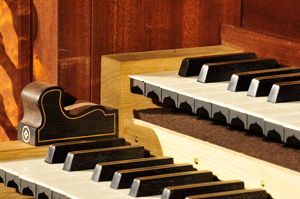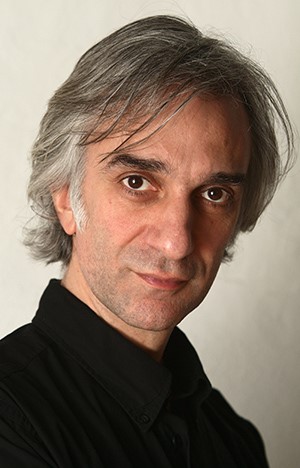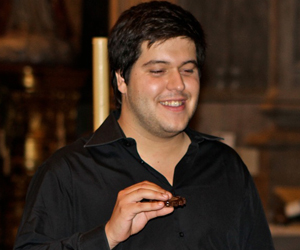 Friday, 19 October, 9.30 p.m.
Friday, 19 October, 9.30 p.m.
Church of São João Evangelista (Colégio)
João Vaz, organ
Pedro Rollin Rodrigues, tenor
Though its origins are from far longer ago, it was its introduction into the liturgy in the 13th century that gave the organ the position it now occupies in western music. The history of the organ and its repertoire is, then, indissolubly linked to the history of liturgy in Europe, both Catholic and Protestant.
As part of the reformation movement, Luther and his followers created an extensive repertory of melodies with text in the vernacular and regular rhythm – chorales – which would come to make up the musical nucleus of the emerging Protestant liturgy. As a means of preparing the congregation for the singing of these chorales, it became usual to perform on the organ a purely instrumental introduction. From these introductions was born the choral prelude, which frequently quoted in its entirety the original liturgical melody, subsuming it into a contrapuntal web enriched by the timbral variety that the instrument allowed. During the course of the variations on the chorale Jesu, meine Freude by Johann Gottfried Walther, the liturgical melody appears sometimes in the upper voice (at times in an ornamented version), sometimes in a middle voice, sometimes in the bass. In the context of a Lutheran assembly, this quotation of the melody would have been easily recognizable, for which reason choral preludes acquired a liturgical value practically identical to that of the sung chorale.
In Catholic countries, plainchant remained the Church’s musical language and inspired, directly or indirectly, the composition of a large number of works for organ. The Kyrie verses by Manuel Rodrigues Coelho (included in his Flores de Música, printed in Lisbon in 1620) were intended to be performed in alternation with the sung chant verses. Similarly, in the Messe pour les Couvents by François Couperin (published in Paris some seventy years later), most of the music is intended for alternation with chant. Neither Coelho’s Kyrie versos nor Couperin’s pieces have any thematic relationship with the plainchant, maintaining only the same tonality. The Glosas sobre el canto llano de la Inmaculada Concepción by the Sevillian composer Francisco Correa de Arauxo (included in his Factultad organica, printed in 1626) are, on the contrary, variations on the hymn Todo el mundo en general (a Spanish melody dedicated to the Virgin Mary), using increasingly rapid ornamentation.
Johann Sebastian Bach wrote during the course of his life hundreds of chorale preludes, some of which are, in their complexity and depth, amongst the greatest examples of the genre. Many of Bach’s choral preludes were brought together by the composer in collections (Orgelbüchlein, Clavierübung III and the so-called “Lepizig Chorales”) which follow the order of the liturgical year. Others were transmitted individually, independently of any collection. The two first works based on the chorale Wer nur den lieben Gott lässt walten included in this programme (BWV 690 and 691) belong in this category and are three-part versions for the manuals, with the cantus firmus in the upper voice. In the second version (for two keyboards) the melody stands out clearly, in a highly ornamented version. The third version (BWV 645) is part of the Orgelbüchlein and is much denser in texture, for four voices and pedals, the cantus firmus also being given in the highest voice.
The diversity of treatment of liturgical melodies in chorale preludes may also be appreciated in the three variations on the choral Ein feste Burg ist unser Gott by the Polish composer Daniel Magnus Gronau. The first variation presents the chorale melody in the upper voice in a three-part version for manuals. The second variation is for two keyboards and pedals, the chorale being given to the middle voice. The third variation is a surprising solo for pedals in which the liturgical melody is heard in the highest notes.
The increasing popularity of Italian opera during the course of the 18th century led, especially in the Catholic countries of the South of Europe, to sacred music being influenced by that style. Orchestral writing and operatic melodies came to be part of church music (including organ music), giving rise to a certain permeability between the sacred and the profane which endured, in Latin countries, until the beginning of the 20th century.
Examples of this musical ambivalence are the XXX Arie pro organo et cembalo by the Neapolitan composer Giuseppe Antonio Paganelli, intended both for performance in the liturgy and in public and private spaces.
While the music of the majority of Latin organists from the beginning of the 19th century was influenced by Italian operas, many improvisations by Louis-James-Alfred Lefébure-Wély, one of the most famous French organists of the first half of the 19th century, seemed to reflect the spirit of the operetta which dominated French taste of the time. The Solo de hautbois ou de trompette harmonique and the Marche pouvant server pendant une procession ou une sortie come from the Meditaciones religiosas, a collection published in 1858 and dedicated to Queen Isabel II of Spain. The Marche is a good example of the composer’s interventions at the end of liturgical ceremonies in the churches of the Madeleine and Saint Sulpice, which earned him such enormous popularity.
João Vaz
The organ in European liturgy
Johann Gottfried Walther (Germany, 1684-1748)
Partitas on Jesu, meine Freude
Manuel Rodrigues Coelho (Portugal, c.1555-1635)
Kirios on the 1st Tone (5 verses)
(Flores de música, 1620)
Francisco Correa de Arauxo (Spain, 1584-1654)
Glosas sobre el canto llano de la Inmaculada Concepción
(de Facultad organica, 1626)
Johann Sebastian Bach (Germany, 1685-1750)
Chorale prelude Wer nur den lieben Gott laesst walten, BWV 690
Chorale prelude Wer nur den lieben Gott laesst walten, BWV 691
Chorale prelude Wer nur den lieben Gott laesst walten, BWV 645
François Couperin (France, 1668-1733)
Tierce en taille
(Messe des Couvents, ca. 1690)
Daniel Magnus Gronau (Poland / Germany, ca.1700-1747)
Variations on Ein feste Burg ist unser Gott
Var. prima à 2 claviature coppulate senza pedale
Var. seconda à 2 claviature con pedale
Var. terza à pedale solo
Giuseppe Antonio Paganelli (Italy, 1710-1783)
Aria II
Aria XXII
(de XXX ariae pro organo et cembalo, 1756)
Louis Lefébure-Wély (France, 1817-1869)
Récit de hautbois
Marche
(Meditaciones religiosas, 1858)
Participants
|
Born in Lisbon, he graduated in organ from the Higher School of Music in his native city, studying with Antoine Sibertin-Blanc, and at the Real Conservatório Superior de Música in Zaragoza, where he studied with José Luis González Uriol on a scholarship from the Gulbenkian Foundation. He also holds a doctorate in music and musicology from the University of Évora. He has been extremely active internationally both as concert performer and teacher, on organ courses. He has made more than ten solo recordings, many of them on historical Portuguese instruments, and currently teaches organ at the Higher School of Music in Lisbon and at the School of Arts of the Catholic University in Oporto. He is titular organist of the Church of São Vicente de Fora, in Lisbon and Artistic Director of the Lisbon International Organ Festival and the Madeira Organ Festival. He was a permanent advisor for the restoration of the six organs of the Basilica of the Palace of Mafra and consultant for the restoration of the organ of the Monastery of Lorvão. |
|
Studied at the Gregorian Institute in Lisbon. He studied singing with Ana Leonor Pereira, Elsa Cortez and Armando Possante. He graduated in choral conducting and musical training from the Higher School of Music in Lisbon, where he was a pupil of Vasco Pearce Azevedo and Paulo Lourenço (choral conducting) and Maria Helena Pires de Matos (conducting and modality in Gregorian chant). He is currently undertaking a licentiate in orchestral conducting with Jean-Marc Burfin at the National Higher Orchestra Academy – Lisbon Metropolitan Orchestra. He has participated in choral conducting courses with Stephen Cocker, Peter Phillips, Owen Rees and others. He sings with the Gulbenkian Choir, the Ensemble Lusiovoce and the Gregorian Choir of Lisbon. He is a founder member and artistic director of the Ensemble Studio Contrapuncti, and teaches at the Metropolitan Music Conservatory of Lisbon. He has been the director of the Children’s Choir of the Basílica da Estrela since 2010. |
Notes about the Organ
 Church São João Evangelista (Colégio), Funchal
Church São João Evangelista (Colégio), Funchal
This instrument, with 1586 sounding pipes, is situated in a religious space with certain particularities. As a church typical of those belonging to Jesuit colleges, with a broad nave and quite a gentle acoustic, the organ had to be specially conceived, especially with regard to the measurements of the pipes. Thus all the pipework of the instrument has been specifically tailored to produce a full sound, and each stop produces a timbre with an individual personality, forming part of a harmonic ensemble based more on the sound of fundamentals and less on harmonics. It was also felt to be essential to give the instrument a certain ‘latin’ sonority that would favour performance of ancient music of the Italian, Spanish and Portuguese schools of the 17th and 18th centuries.
Another aspect to be taken into consideration was the need to complement the current range of organs available locally: the new organ responds in an ideal fashion to the performance of works of periods and of technical and artistic requirements that none of the 24 historic instruments of Madeira cater adequately for. It also enhances the range of organs that constitute the island’s heritage by being present in this particular religious space, as well as by existing side by side with other historical instruments. In the decision to build it for this church, not only were the issues of acoustic, aesthetic and liturgical space taken into account, but also the presence there of an important historic instrument which is currently on the list of instruments undergoing restoration.
I Manual - Órgão Principal (C-g’’’)
Flautado aberto de 12 palmos (8’)
Flautado tapado de 12 palmos (8’)
Oitava real (4’)
Tapado de 6 palmos (4’)
Quinzena (2’)
Dezanovena e 22ª
Mistura III
Corneta IV
Trompa de batalha* (bass)
Clarim* (treble)
Fagote* (bass)
Clarineta* (treble)
II Manual - Órgão Positivo (C-g’’’)
Flautado aberto de 12 palmos (8’)
Tapado de 12 palmos (8’)
Flautado aberto de 6 palmos (4’)
Dozena (2 2/3’)
Quinzena (2’)
Dezassetena (1 3/5’)
Dezanovena (1 1/3)
Címbala III
Trompa real (8’)
Pedal (C-f’)
Tapado de 24 palmos (16’)
Bordão de 12 palmos (8’)
Flautado de 6 palmos (4’)
Contrafagote de 24 palmos (16’)
Trompa de 12 palmos (8’)
Acoplamentos
II/I
I/Pedal
II/Pedal
* horizontal reeds
 João Vaz
João Vaz Pedro Rollin Rodrigues
Pedro Rollin Rodrigues